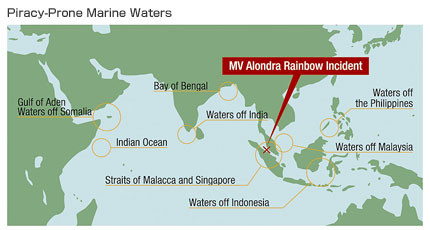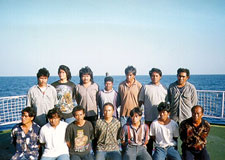Ocean Newsletter
No.198 November 5, 2008
-
The Pirates And Indo-Japan Relations
Prabhakaran PaleriFormer Director General, Indian Coast Guard / Visiting Fellow, OPRF
There have always been fluctuations in the rates of piracy, though no government has ever been able to completely eliminate it. Piracy still exists, with ever-changing forms and methods, and might also evolve into terrorism. Beginning with the Alondra Rainbow Incident, Japan and India have built up a cooperative framework and continue to work for the elimination of piracy. There is a need for detailed surveys of areas along sea-lanes and commercial sea routes where piracy might be expected to occur as well as a cooperative mechanism for securing the safety of navigation.
-
The Effects of Climate Change and Sea Level Rise on Coastal Zone Disasters
Hiromune Yokoi Associate Professor, Center for Water Environment Studies, Institute for Global Change Adaptation Science, Ibaraki University
In 2007 the Fourth Assessment Report of the Intergovernmental Panel on Climate Change was adopted. This report contained a stronger message than previous reports concerning anthropogenic factors of global warming. There exist two schools of thought regarding responses to global warming and climate change: mitigation strategies and adaptation strategies. Mitigation strategies attempt to slow global warming and climate change by reducing the emission of greenhouse gases into the atmosphere; but this alone is not enough. There is a need for the immediate adoption and implementation of adaptation strategies to cope effectively with the actual effects of global warming and climate change.
-
What We Can Learn from the Graves of the Bunka-era Aizu Retainers Sent to Guard the Ezo Area
Eiji Nishiya Section Chief, Arts & Sciences, Rishiri Town Museum
Mount Rishiri stands loftily in the center of Rishiri Island. At its base can be found the graves of eight retainers from the Aizu feudal clan, with "the 5th Year of Bunka, Boshin" (1808) carved into the headstones. This was the year, in the latter days of the shogunate, that the Aizu and other northern feudal clans were ordered to send retainers to guard the Ezo area, as the Russians had begun their raids into the area. In whatever period, the ocean always serves as the stage for diplomatic history. The graves of the Aizu retainers remind us how the challenges of the ocean must always be met.
The Pirates And Indo-Japan Relations
When I was a child I dreamt of being a pirate?Eis what many adults would say. Children encounter pirates in comic books, memorabilia’s, merchandise, animation, videos and movies. No other criminals are eulogized like the pirates. I am not sure whether I thought that way as a child but certainly had a feeling of worsening situation around the world when struggling to lend a hand to my colleagues and seniors in building the Indian Coast Guard in the late 70s.
Piracy existed since vessels could ply on water. The early pirates used the sea for raiding the coasts and villages, some of them forayed even far interior. The form and methods changed when they achieved mobility further into the sea. In course of time they restricted their activities to the sea. Pirates don’t raid coastal towns any more. But they use them as hideouts, contact points and forward planning centres. But what is important is that, though piracy had its ups and downs similar to the fluctuations of a stock market, no government has ever been able to eliminate it. Even the young Julius Caesar was kidnapped by the deadly Cilician pirates once for ransom. Though he eliminated them subsequently after release, their successors bounced back and sailed smoothly into the ‘golden age?Eof piracy. In all its probability piracy is here to stay and float into the future. The approach and modalities may undergo change. Could it be terror in its container mode? If that is so the ancient piracy will be resurrected by opening its original modus operandi of attacking at sea, and from the sea over the shore. Nothing prevents a maritime terrorist from negotiating an attack with a missile tipped dirty weapon deep into the land from the sea. Today the sea is a medium for them to glide their supply chain of dreaded cargoes and militant mercenaries. Tomorrow it could be different.
The pirates exist in all forms and shapes in the modern world. There are poverty stricken petty thieves and anchorage muggers in almost every navigable port of the countries whose security forces are weak and lax in their duties. There are also pirates of the high seas who are better organised. Some of them operate under powerful and organised syndicates with formal orders. They have the no holds barred attitude for violence against their victims. They can go to the extreme in executing their mission to hijack a ship and its cargo and then run it as a phantom ship. For the victims it will be life long trauma even if survived the assault.

 The pirates of MV Alondra Rainbow
The pirates of MV Alondra Rainbow
There is no organised piracy in India. But there were incidents of thieving in some of its ports and anchorages by unsuspecting boat people including fishers without a catch on that day. They boarded ships without deck watch at anchorages and stole the wears to earn a living. The Indian Coast Guard stopped it. It was recognised by the International Maritime Bureau in London.
But the Indian Coast Guard never felt it would end up seizing the operatives of an organised syndicate of the South China Sea until the hijacked Japanese ship Alondra Rainbow dared to traverse Indian waters on its way to Persian Gulf to negotiate resale as a phantom ship. It also opened a new chapter in Indo-Japanese relations with the prime ministers of both the countries taking interests in collaboration and further coordination to eliminate the bane of piracy jointly. It worked, and today there is a revitalized approach in Indo-Japan relations and people to people coordination. I have been a participant and observer in all these developments including the subsequent ReCAAP1. It is for both the countries to derive more mileage out of this initiatives for which the main cause was the pirates of the South China Sea.
In the meantime piracy is extending its tentacles in many parts of the world as an organised criminal business in its localised form. African continent is witnessing new types of piracies. While Somalia with its clannish militia finds piracy as a major source of finance, the pirates of the oil rich Niger Delta has reinvented themselves as stake holders of big game money according to media reports2. There were incidents of kidnapping for ransom as well as attacks on Nigerian Navy. They also found easier means of income in the weaker section of the population of the Delta?the fishers. The fishers sleeping after streaming their nets down expecting a good catch by morning are woken up in the dead of the night by machine gun fire from the pirates who board them. Often they get shot and die. The pirates take away everything. Pirate attacks on offshore oil installations and kidnappings continue. The European Command of the United States, it is understood, has plans for activating the Gulf of Guinea Guard to patrol the area3. The Central and Western African States are also planning a joint continental coast guard4. But the greatest burden of lawlessness percolates to those in the lower rung, in this caste the fishers of Niger Delta. There were 107 cases in 2007 according to the Nigerian trawler owner’s association. The raids are increasing.
Under such circumstances it will be of interest to examine the probable spots of piracy that may come up later in the sea lanes and shipping routes. It will depend on the social, political and economic system prevailing in the area. The northern sea route that is being examined currently could also be vulnerable for unlawful activities5. It has to be studied in detail from this perspective to contain them by cooperative mechanisms designed to ensure safety of navigation.
- *The Regional Cooperation Agreement on Combating Piracy and Armed Robbery against Ships in Asia (ReCAAP) is the first government-to-government agreement to enhance the security of regional waters. ReCAAP was entered into force on September 4, 2006. It comprises 14 member countries which includes Japan, Singapore, Laos, Thailand, Philippines, Myanmar, South Korea, Cambodia, Vietnam, India, Sri Lanka, Brunei, China and Bangladesh (as of May, 2007). Please refer to the OPRF MARINT Monthly Report June 2006.
- Will Connors, Delta Pirates are Now Targeting Nigeria’s Smaller Fish, International Herald and Tribune, Tokyo, 13 Jun 08, p.2.
- www.globalsecurity.org, September 1, 2008
- West and Central African States to Co-operate in Sub-regional Coastguard Network, www.imo.org, September 2, 2008
- Based on a study by the author on the Maritime Dimension of Unlawful Activities for the Institute for Defense Studies and Analyses, New Delhi as an external researcher. It was not an area specific study.
